VULNERABLE LANDSCAPES: THE PASTORAL IN THE POETRY OF PHILIP HODGINS
By Brendan Ryan
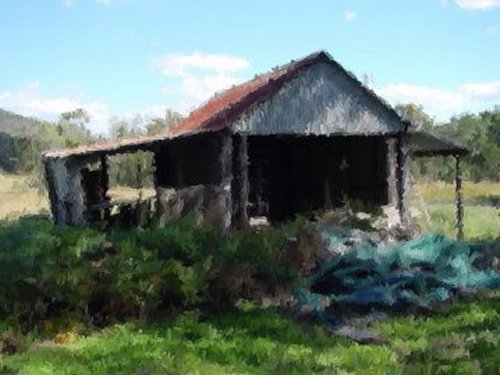
[Above] Nostalgia (Artwork by Coral Hull, 2003)
With Philip Hodgins' untimely death in 1995 at the age of 36 from leukaemia, Australian rural poetry suffered a great loss. Hodgins was renowned for his laconic narratives, or 'farmscapes' as he called them - a challenge to the Euro-centric view of landscape. His language was understated and owed a debt in its phrasing to Robert Frost, where the 'humble, everyday phrase becomes a medium for expressing the most serious ideas'. [1] In this study of the pastoral poetry in Philip Hodgins' writing I will discuss the poems of his which faithfully reproduce the pastoral tradition with those which critique it.
The prospect of imminent death from leukaemia and the evocation of a former rural life were two themes which dominated Hodgins' pastoral poems. Since his death the Australian rural world has continued to be written of in earnest, and perhaps by none more so than the expatriate W.A. poet John Kinsella, now based in Cambridge, U.K. Kinsella's pastorals share a concern with Hodgins' in that they focus on 'the interaction (mostly in a negative sense) between humans and nature'. [2]Although both poets write from a rural perspective, of people who grew up on the land, they are divided by their moral views of nature, which for Hodgins was a process of decay and growth, where nothing is 'ugly or wrong'.[3]
Although pastoral poetry has undergone many changes and forms since Theocritus, Hesiod and Virgil were writing, the traditional formal structure of pastoral appears to have remained unchanged. This formal structure comprises a field of alternatives which include the establishment of truths in country settings for a city audience, contrasting past with present, nature with dying shepherds.[4]
'The scholars of pastoral' writes Ivor Indyk 'tend to fall into two groups: the purists who regard ease of fulfilment as the proper mood of pastoral to the exclusion of all other concerns and the Virgilians who are forever using pastoral to speak about other concerns'. [5]Hodgins can be described as Virgilian, in the way he uses pastoral to describe the relationship between farmers and their animals, the effects farming has on land and the loss of his former childhood.

[Above] Nostalgia II (Artwork by Coral Hull, 2003)
When he was eighteen, Hodgins' parents were forced to sell the family farm as it was too small to be profitable.[6] The sale of the farm became a major factor contributing to his focus on the past, and on memory to recreate a lost world of childhood. Three early poems where he explores this loss of a former life are 'An Education' 'Going Back For a Look' and 'The Past'. In 'Going Back for a Look', (S.P p88) Hodgins' exploration of the past becomes an affirmation of change, of gaining perspective from loss, as he realises that 'what I wanted isn't there'.
What Hodgins sees in 'the places around the billabong' activates his desire to return for a 'stare'. These places become charged with a mythic quality, as Hodgins confirms the contradiction between memory and the physical reality of land. The loss he experiences reflects his particular way of looking at land, of land sharing the burden of his own loss. He writes of the land through his own self, his body; as if the land too was diseased, wracked by a terminal illness, with instances of death becoming commonplace as 'six chooks dead/ and scattered in bits'. ('The Meaning', S.P p282)
In 'The Farmer' light becomes a framing device for a scene that is commonplace in the rural world.
'He starts each day before it is a day,
the little kitchen spreading buttered light
across the yard while he stokes up the stove' (S.P p166)
The poem is sustained by the dairy farming rituals it recreates and celebrates in a quiet, understated way. As a pastoral poem, it's mood is more Theocritan than Virgilian, by the way the farmer is evoked as a humble, stoic figure closely connected to his herd.
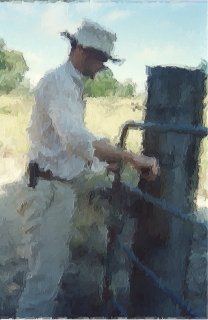
|
The retrospective tone of the poem suggests a loss Hodgins was conscious of keeping under control, yet allows the reader to glimpse with: 'No need to write it down. It's what he is'. The caesura in this line reminds the reader of what Hodgins isn't, but might have been. The poem recreates the farmer's world with a warmth of observation similar to Seamus Heaney's 'Sunlight': 'the reddening stove/ sent its plaque of heat/ against where she stood'.[7] In the final quatrain, Hodgins returns to processes of light, unifying the poem with an understated balance, and a final line which echoes Larkin's 'Aubade'.
'and by the time they reach the milking shed
it's light enough to see what's always there'. (S.P p166)
Unlike Robert Gray's rococo descriptions of light, Hodgins succeeds in this poem with language that is plain, and more resonant of larger connections. In poems like 'The Farmer' Hodgins challenges John Kinsella's view that 'there is no idyll possible now'.[6] |
[Above] Nostalgia III (Artwork by Coral Hull, 2003)
Kinsella, who is currently working on a critical book on the pastoral, suggests 'there is a new generation of farmers (who) have a genuine sense of belonging through knowing no 'other' place, and that this is a kind of negative identification'. [8]All the images in 'The Farmer' are life-affirming, warmly drawn with an unspoken history of belonging to a 'place' behind them. Although Kinsella may consider that, like Heaney, Hodgins' pastorals belong to the past, to suggest that traditional pastoral idylls are no longer possible in Australia, denies the possibility of change and adaptation within the pastoral form. Even Kinsella's anti-pastoralist poems such as 'The Rabbiters: a pastoral' and 'Dematerialising the Poisoned Pastoral' from The Hunt which challenge the concept of 'pastoral as urban moral guidance'[9] rely upon an urban audience for their reception. While Kinsella's mix of realism and intellectual experimentation challenges the idealised view of the Theocritan pastoral, a view stemming from centuries of reinterpretation of The Idylls, his anti-pastorals still operate within the context of traditional pastoral, by portraying the rural world through an urban view. Apart from 'The Farmer', Hodgins shows in other poems including Dispossessed that a sense of belonging to land is full of contradictions and darker truths urban Australians may be unaware of.
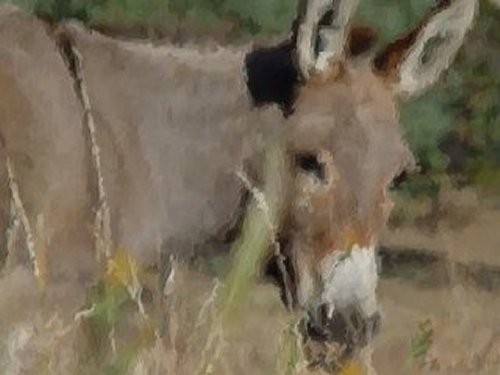
[Above] Nostalgia IV (Artwork by Coral Hull, 2003)
A catalyst for much of Hodgins' dark view of the rural world is his concern for the treatment of farm animals. It is a concern shared by Kinsella and evident in his recent collections The Silo and The Hunt. Like Hodgins, Kinsella portrays a tough, rural world where death is omnipresent in farm accidents, dogs killing sheep, and kangaroos killing dogs. If there is anything idyllic in Kinsella's pastorals, it is the dry, colloquial humour of his characters, that are mostly caricatures of an idealised male resilience.
'That it was a bumper
crop was the source
of much laughter
at the pub. Childless
he was considered
more fertile dead than alive.' (The Hunt p14)
Although Kinsella's book is titled The Silo: A Pastoral Symphony, and Beethoven's Sixth Symphony is used as a framework for the collection, Kinsella goes out of his way to dispel the idea of Arcadia in the Western Australian wheatlands. Many of the poems are realist depictions of rural violence, farm accidents, indeed the negative components of rural life. Like Hodgins, Kinsella uses colloquial language as befitting his subjects, however a tension exists between Kinsella's more linguistically experimental poems - 'The Fire Mist: The Return from Exile?', 'Cairns' and more straightforward narratives - 'Collecting Wood Near Williams Cemetery'. By contrasting different narrative forms Kinsella exposes their artificiality, and raises the question of what the pastoral form is. However the tensions of traditional pastoral remain in the back of his mind, and with the urban audience Kinsella is waiting to hear from.
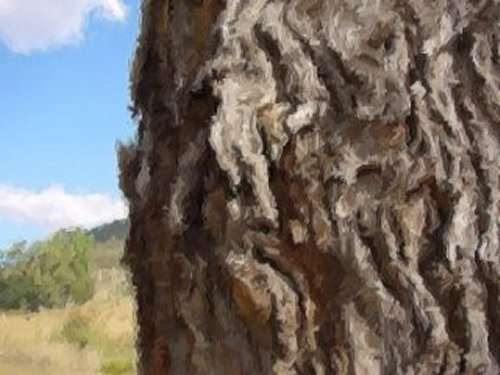
[Above] Nostalgia V (Artwork by Coral Hull, 2003)
While Kinsella shares with Hodgins a dark realism in his pastorals, the two poets are contrasted by the scope of their empathy toward the treatment of animals on farms. This difference may be related to the two distinct types of farming each poet writes of. Kinsella's rural world is drawn from wheat farms, kangaroos, parrots, roo dogs - animals on the fringe of a day devoted to harvesters and silo bins. Hodgins writes of dairy cows, pigs and farm dogs - animals that have been domesticated and brought into closer contact with people. It is this close contact with animals that enables Hodgins to describe their occasional violent treatment in a direct, conversational style; a style which neither repudiates nor glorifies the farmer's actions. Indeed he addresses this unfortunate part of rural life with an acceptance that is evident in many of his poems dealing with cancer.
In 'Chopped Prose With Pigs' Hodgins focuses on the brutality of animal death without sentiment or rhetorical overstatement. His lines may be prosaic and narrative-driven, insisting on the vernacular with a rural bluntness.
'I coaxed her into a single pen mechanically
and smashed her between the eyes
with a hammer.' (S.P p83)
These lines occur three-quarters of the way through a poem that has already described other gory incidents in the lives of pigs on farms. And yet the lines still manage to catch the reader off-guard as the poem's subtly drawn narrative lulls the reader into a humorous sense of security. Towards the end of the poem, Hodgins takes the reader in close to his subject, and in doing so suggests the attachment he has to farm animals. It is an attachment that is the opposite of Kinsella's 'bitter cold' invoked at the end of 'The Hunt'.
'Reaching in for the rest
had me disgorging handfuls of animal warmth.' (S.P p83)
To reach inside a pig and feel the heat of its liver, intestines and blood around your arm is an act that represents a powerful connection between people and pigs. Although 'disgorging' implies a removal of warmth from the pig, the phrase 'reaching in' suggests a desire for such warmth.
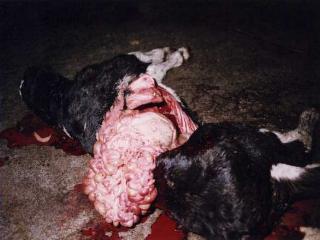
|
By placing 'animal warmth' at the end of the line Hodgins emphasises its transference between pig and narrator. The disembowelling of a pig may not have been a subject worthy of Virgils' pastorals, although Les Murray has written of it in 'Blood'.[11] What stops Hodgins' narrative from becoming just another catalogue of rural violence is this 'animal warmth' he shares with his subjects. The title of his third collection, Animal Warmth, reflects the acceptance Hodgins had, or aimed for, when writing of everyday rural deaths. |
[Above] Dairy Industry Calf, Dandenong Stock Market, Victoria, Australia (Photo by Sean Poyser, 1995)
In comparison, the final poem of Kinsella's sequence 'Shootings', reveals the moral viewpoint he often brandishes with his animal narratives.
'I renounce the hunt, the flesh, the kill.
I embrace the sting of a cold morning,
the flight of the parrot, the bark
of the fox, the utility of the rabbit.' (The Silo p55)
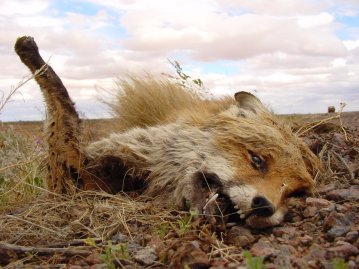
|
It is a viewpoint Kinsella continues to explore with the title poem from The Hunt, where the mythical Tiger (was it Tasmanian?) becomes a subject for a poem deploring the cold-hearted treatment of a feral animal. In 'The Shoot', Hodgins allows the reader to decide where his concern originates from, when he begins on an ironical note - 'The rabbit shoot was bags of fun.' But in the final two lines, even the death of a rabbit has become just another 'vehicle for death', another way for Hodgins to accept the 'truth' of his own vulnerability.
The declaration of life being often tragic and full of 'rituals that must be carried through' is a theme which occurs throughout Hodgins' writing. |
[Above] Fox, Stuart Hwy, South Australia, Australia (Photo by Coral Hull, 2001)
In 'Three Pig Diseases' he explores the everyday nature of rural life to show the inevitability of death within the flow of life.
'Life is offering itself from those teats,
swelling, dripping, souring
and the piglets just won't drink.' (S.P p162)
If Hodgins suggests the piglets' struggle to survive is 'like an obstinate belief' against 'a pattern clenching against growth', the second poem, 'Erysipelas' suggests the pattern is man-made. The pigs' disease is something the farmer has brought on himself by not acting earlier. He looks at the 'reddish-purple wrinkled shapes' on their skin and thinks of pieces of salami laid out in 'piggy colours' in a supermarket.
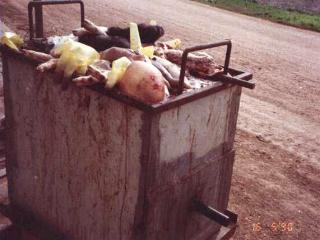
|
This image may have a different resonance for a vegetarian, but Hodgins prefers to emphasise the interdependence between country and city, as well as implying the city as a place where people are removed from contact with farm animals.
'The image of a supermarket deli passes through his mind,
a range of processed meats
.... laid out on plastic trays behind the glass,
all of it so cold and clean.' (S.P p163)
The disease has entered the farmer's existence. It has got inside the railings, the dirt and is the cause of the family's uncertainty. |
[Above] Pigs in Barrels, Bunge Pig Farm, Corowa, New South Wales, Australia (Photo by photographer unknown, year unknown)
Hodgins is offering a late twentieth century update to Wordsworth's views of the relationship between humans and nature. No longer is it possible for nature to be a beneficent fount for man's imagination to draw sustenance from.
Hodgins' unity between man and nature includes the cold facts Wordsworth never had to face as a poet walking through the Lake District and living off an inheritance. Nature, for Hodgins, is a life cycle imbued with destructive elements which people inherit and pass on. At the end of 'Erysipelas', the farmer has to destroy what he has created. Nature is diseased and yet Hodgins finds something durable in a ritualised family tradition.
'Loading the rifle for the first of many times
he wipes the bullet through his hair,
a habit handed down by his father,
who always oiled a bullet or nail that way
before he banged it in.' (S.P p163)
In 'Shooting the Dogs' (S.P p86-87) Hodgins writes of an unfortunate, yet sometimes necessary situation that might have lesser poets overstating the point. In many ways it is another poem bound up with differences in meaning between rural and city readers. The poem is a kind of bleak pastoral, framed by the tough decisions rural people often have to make. 'It was one of those things', Hodgins suggests in the acceptance of the dogs' approaching deaths. A person brought up in the city with domestic dogs may view this situation with horror. They would most likely call the R.S.P.C.A or the local Pound, regardless of those authorities having to put the dog down two weeks later. A farmer who is accustomed to looking at life through the functions and uses of his dogs, cows, pigs, and paddocks, might view the shooting of dogs as an unpleasant but necessary step before the next dog or farm. Also, as Hodgins suggests, 'we couldn't take them with us into town', the chances of a country-bred dog surviving in a city might be minimal.
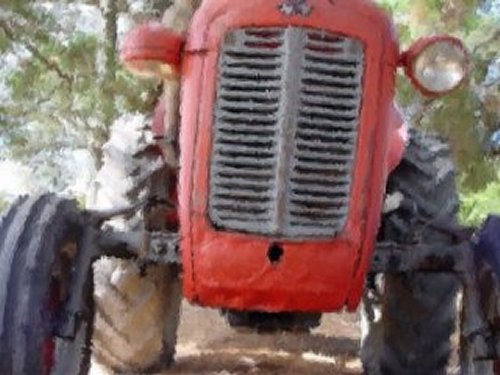
[Above] Nostalgia VI (Artwork by Coral Hull, 2003)
Although 'Shooting the Dogs' may appear as a catalogue of anecdotes on a first reading, by the final stanza the reader is left with the pain of separation from such a history.
'I buried them behind the tool shed.
It was one of the last things I did before
we left.
Each time the gravel slid off the shovel
it sounded like something
trying to hang on by its nails.'(S.P p87)
In this stanza Hodgins' empathy for the dogs reaches an emotional depth Kinsella seems to lack. His language is plain, uncluttered and spare. Hodgins seems to not only to have found humble, everyday phrases to express serious ideas, he has found an image which encompass' the tragedy of the dogs' deaths without resorting to melodrama. Perhaps this image is more startling for the sound it evokes, as much as evoking that final desperate moment where a dog loses its grip on life. Like 'Little Elegies' and other bleak rural poems he wrote, 'Shooting the Dogs' appears to succeed as a contemporary pastoral by the differences in meaning Hodgins leaves between the lines.

[Above] Nostalgia VII (Artwork by Coral Hull, 2003)
In a review of Up On All Fours, Martin Langford wrote, 'there is a conservatism in the country which has a crippling effect on the imagination: an incuriosity about human society - as if all the answers were known by practical men'.[12] This is an important point to consider with Hodgins, as many of the characters that pass through his poems become vehicles for the greater truths Hodgins finds in rural life. Every poet it seems has their obsessions, and writing of relationships and human society wasn't one of Hodgins' strengths. When interviewed on writing about cancer Hodgins said, 'Some of my friends thought I was becoming obsessed with my illness and suggested I steer my poetry away from it. But I think it was Robert Lowell who suggested "trust your obsessions" [13]Langford also suggests the laconic note which Hodgins mostly employs 'can make many areas off-limits to the imagination', unless it is 'liberated by the one allowable Aussie emotion, grief'.[14] Perhaps like Martin Johnston who wrote about the unrelenting pain of a break-up in 'Grief', Hodgins cannot avoid the laconic note as a way of accepting that 'the dying time is now'.
'Love is the subject and love's loss the text.
Grief breaks the heart and yet the grief comes next.'[15]
The persistence of loss and the reality of a grief that won't go away which Johnston evokes in this poem are themes which inhabit the tensions of Hodgins' cancer poems as well as a few of his rural poems. In 'Cytotoxic Rigor' the last line has a surprising echo of the rhythms in Johnston's poem - 'And when there's nothing left to vomit, you vomit again.' (S.P p 318) Being told that he was about to die forced Hodgins to write about what many of his readers deny. It would have been a greater conservatism on Hodgins' behalf if he had shared in that denial, and similarly, if he had written of the land only as befitting traditional pastoral forms.
In Dispossessed Hodgins turns to blank verse as a means of exploring the tensions between rural characters and their relationship to land. Although Hodgins' ten syllable lines refer to the blank verse form, his use differs from Milton's Paradise Lost or Wordsworth's The Prelude, in that the flat rhythms of his language contribute to the restraining tensions which hold the novella together. The lack of communication between characters is understated and controlled by Hodgins' laconic voice, a control which spares the novella the melodrama of Murray's The Boys Who Stole the Funeral.
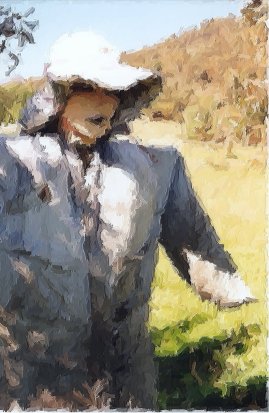
|
The title Dispossessed echoes the title of Virgil's first eclogue- 'The Dispossessed', and in fact Hodgins even referred to the novella in an interview as The Dispossessed. Virgil's first eclogue is also framed by a city/country conflict where shepherds are being ousted from their land following the civil war after Julius Caesar's death. The authorities in Rome have to find land for the settlement of discharged war veterans. Likewise Hodgins' novella uses the conflict between banks and farmers as a backdrop to more prominent tensions in the narrative: the emotional dispossession between characters, the dispossession of land, as well as Hodgins' understated political views on Aboriginal ownership of land.
In a review of Dispossessed, Christopher Pollnitz suggests Hodgins 'wants to show (his characters) skirting abysses they're too stoic to topple into'.[17] However, Pollnitz forgets that Len and Max may not have the language to confront such abysses. Their 'stoic' personalities stem from their inability to articulate their wordlessness, as both of them have 'heard it all before'. (S.P p219) Although Hodgins keeps these tensions under control, suggesting the change Max and Len will inevitably adopt, the emotional landscape Len and Max share appears at best as vulnerable. |
[Above] Nostalgia VIII (Artwork by Coral Hull, 2003)
Their future together seems to be composed by their history of arguments, Max's lack of understanding and Len's capitulation to Max's authority. Similarly, Hodgins reminds the reader of the tensions within the landscape. Not only are things connected in nature, but they are in constant danger of being lost or changed. Many of Hodgins' physical images achieve their clarity through their interplay between visual beauty and a darker metaphorical presence.
'The wires around the trunk
had cut into the bark the way the strings
around a rolled roast cut into the fat. (S.P p248)
Although the use of a tree as strainer post implies a close connection between people and land, Hodgins emphasises the negative effects of such a relationship. The tree bears the marks of its 'use', and the strangling hold of the wires on the tree produces a 'ruby sap', not unlike the way cancer had a hold on his body. Hodgins' rural perspective enabled him to describe these human effects on landscape effortlessly with images suggesting the vulnerability farming landscapes are subjected to. In an interview with Janet Chimonyo, Hodgins confirmed some of the political motivations behind the writing of Disposessed. '... it's about land rights, notions of land ownership, it's about Aboriginal Australia in that there are no Aborigines in the book, and that itself's a comment.' [18] An Aboriginal past is only mentioned in passing in the narrative, as with POISON CREEK, or when Liz thinks she has stumbled across an Aboriginal fish-trap.

[Above] Nostalgia IX (Artwork by Coral Hull, 2003)
Unlike the violence and deaths Aborigines suffered, Len and Liz have been dispossessed by the banks. As with 'Second Thoughts on the Georgics' Hodgins suggests farming has become an argument of economics that doesn't tolerate small, struggling farmers. These economic tensions contribute to the flat tone of desperation that runs through the novella. At the conclusion, where Max is living with the snake, (his demons, and a battler image reminiscent of 'The Drover's Wife') and no new trees are coming on down by the treeline 'because of years of grazing stock', Hodgins asks who or what does have rights to the land. Is it Aborigines, the banks, Max's mental map, or Liz and the connections she finds on her walks? The open-ended conclusion complements the restraint and understatement Hodgins uses throughout the narrative.
In Things Happen Hodgins continues to explore tensions within the rural world but perhaps the collection is notable for his return to his cancer poems, and for the way Hodgins blurs the differences between his cancer poems and his rural poems, as he writes metaphorically of changes in landscape reflecting the breaking down of his body. In "A House in the Country', (S.P p286-287) Hodgins appears to be literally digging for connections between his battle with cancer and termites in the house. Unlike Heaney's metaphor in 'Digging' [19] where a mythic connection to land is established with the past by the narrator watching his father dig in the garden, Hodgins' digging with a jemmy exposes a different connection.
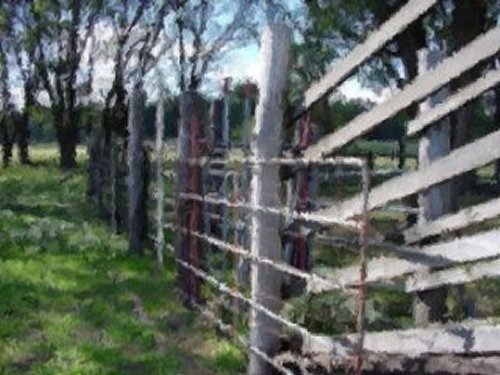
[Above] Nostalgia X (Artwork by Coral Hull, 2003)
Heaney chose not to dig like his father - 'I've no spade to follow men like them', and so the poem becomes an occasion for victory in the face of defeat as Heaney opts for the marks of a pen. However, Hodgins' prodding and 'rowing' a jemmy through rotten studs exposes a connection of ruin he has with the house. Like bad blood, the termites are spilling in a concentrated flow between the stumps. Indeed, a cure for such energetic ruin appears as helpless as finding 'the bloated queen, an evil sausage producing more/ and more termites'; an image reminiscent of the mother monster in Alien fertilising her rows of pods. By the end of the poem Hodgins leaves no doubt as to the invading presence of death. 'I set off at a fast walk, worried about/ what was going on beneath my feet'. This connection to ruin within the land is similar to the connection Hodgins suggested in 'Erysipelas'; between the pigs' disease and what was on the farmer's boots. Again, he suggests the unity between man and nature is not wholly positive, and perhaps merely reflective of the state of those connections.
With 'The Land Itself' (S.P p285) he explores a more traditional form of pastoral, where an elegiac mood is evoked between the land cracking 'like a vast badly-made ceramic' and the scientists studying the land with computers. 'Beyond all arguments' echoes Kenneth Slessor's 'As if the argument of trees were done' from 'South Country'.[20] The two poems are linked by their subject material - flat landscapes, as well as the inevitabilities of loss each poem evokes. And yet Hodgins' poem lacks the tension of Slessor's last lines - 'As if ... something below pushed up a knob of skull,/ feeling its way to air'. The casual, easy flow of Hodgins' language reinforces the space and openness of the landscape, but it is familiar territory and rarely surprises.
'they make walking tracks that run like scars
across the bitten down paddocks stitched with fences.' (S.P p285)
Perhaps it is the distance within the gaze of the writer toward the land that limits the reader from becoming as intimately involved with the landscape. Unlike the close-up concentrated view of land in Dispossessed, Hodgins lapses into generalisations - 'punishing the land for being so old and delicate'. Although a gap of understanding is suggested between the field geologist's computer screen and what she sees through 'the dust-filtered window', it is a relationship that is barely explored.
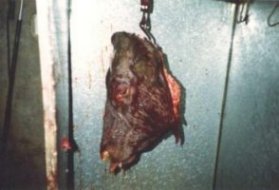
|
However, in 'Midday Horizon' (S.P p292) Hodgins succeeds with a poem that explores a similar landscape to 'The Land Itself'. This is partly due to the language that is fresher and more concentrated - 'a fine graph line/ as nervy as a lot of black snakes in the heat'.
There is more urgency in these lines, a greater tension holding the images together. Even though Hodgins describes a typical rural scene, he manages to invest that rural world with some of the unnameable terror that inhabits his cancer poems. |
[Above] Cow's head hanging on chain, Wollondilly Slaughterhouse, Tahmoor, New South Wales, Australia (Photo by photographer unknown, year unknown)
As with many of his poems there is a solitary figure in a landscape, but this time with a dog and sheep. The reader follows the eye of the narrator watching the man and dog 'walking through different dimensions'. Like the tenuous form of the mirage, the man is caught between forms, as he 'slips into separate pieces'.
Hodgins' concentrated view meticulously depicts the illusion of the mirage, and in doing so reveals the land in an unadorned way, and this draws attention to those connections between land and people. Hodgins' awareness of his own mortality and of his farming knowledge of the land as being vulnerable, is suggested in the final three lines, where beneath the surface of the landscape natural forces are suggested.
'You notice the silence, how near it is.
There's no threat you can see
and yet the thin exposed horizon trembles.' (S.P p292)
Regardless of the different interpretations possible to these lines, their sense of foreboding is reminiscent of 'the wordless afternoons', and the hospital spaces of the cancer ward. There the silence, and its subsequent threat of continuing, would have been a presence Hodgins had to accept. The phrase 'how near it is' is remarkable for the way it laconically suggests a threat within the silence, and the fragility of connections between land and viewer.
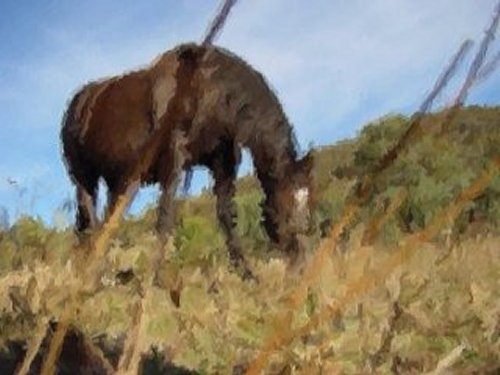
[Above] Nostalgia XI (Artwork by Coral Hull, 2003)
The developments which occurred in Hodgins' poetry parallel the changes he made to his own definitions of pastoral. In his early poems Hodgins was not only looking back at the rural world, he was drawing on the pastoral tradition of Hesiod and Virgil to find connections between self and landscape. His view of nature as including destructive elements which people participate in, and his concern for the treatment of farm animals challenges Theocritan pastoral views of shepherds playing flutes and singing to each other. Hodgins' view of nature is reflected in the point Richard Rossiter made at a recent conference on 'Land and Identity':
'Nature is no longer represented as an Other-that-which-I-am-not
and nor is it an 'objective correlative' of a true self - but it becomes
'that-which-I-am'. [21]
Unlike Kinsella, who shares these concerns with Hodgins, Hodgins wrote of the darker truths of nature with a warmth of observation, and an acceptance of its violence. In his last two books, Dispossessed and Things Happen, Hodgins' rural perspective alternately celebrates the rural world and depicts rural landscapes in a state of physical fragility. Dispossessed is one long pastoral poem imbued with the conflict and tensions characteristic of Hodgins' best work. His realistic portrayal of rural poverty is reminiscent of the attack Patrick Kavanagh's The Great Hunger (1942) made on Irish literary nationalism and the idea of an 'Irish spiritual ascendancy, ... largely centred on peasant Ireland'.[22] In 'The Effect', (S.P p63) Hodgins wrote of the possibility of giving in to death, and that 'maybe I've had it/ wrong all the time. Too tense'. If tension is characteristic of Hodgins' cancer poems, it is also a quality he brought to his better pastorals, and in doing so, broadened the possibilities of the Virgilian pastoral form.
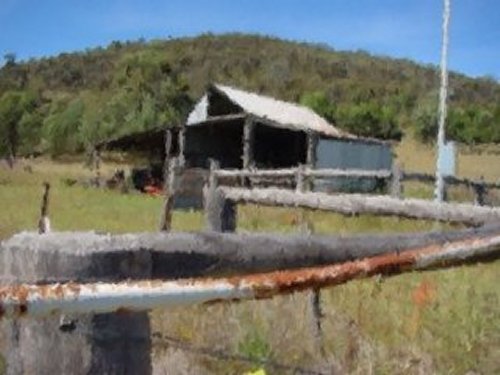
[Above] Nostalgia XII (Artwork by Coral Hull, 2003)
Footnotes:
[1] Lynen, John F, The Pastoral Art of Robert Frost, Yale U.P, New Haven, 1960, p10
[2] Interview with John Kinsella by Brian Henry, Verse, Vol 15, No 3, Vol 16, No 1, 1998 p68.
[3] Hodgins, Philip, 'The Precise Moment', Selected Poems, p322-323
[4] Fox, Robin Lane, Hellenistic Culture and Literature in The Oxford History of the Classical World, O.U.P, 1986, p358
[5] Indyk,Ivor, The Pastoral Poets, in The Penguin New Literary History of Australia, Penguin, 1989, p9
[6] Chimonyo, Janet, The Long Apprenticeship, The Age Saturday Extra, 18 Dec., 1993, p8.
[7] Heaney, Seamus, Opened Ground, Poems 1966-1996, Faber and Faber, London, 1998, p93.
[8] Kinsella, John, The Pastoral, and the Political Possibilities of Poetry, Southerly, Vol 56, No.3, Spring, 1996, p37
[9] Verse, p69
[10] Wells, Robert, Trans. and Intro. Theocritus, The Idylls, Penguin, 1989, p24
[11] Murray, Les, Collected Poems, Heinemann, 1994, p20
[12] Langford, Martin, Southerly, Summer, 1994-95, p174.
[13] Usher, Rod, Illness as a Vehicle for Verse, The Age, 1986, 1 November, p9.
[14] Langford, p175
[15] Johnston, Martin, Selected Poems and Prose, U.Q.P, 1993. p96
[16] Chimonyo, 1993, p8
[17] Pollnitz, Christopher, There's No Rhythm, but Plenty of Blues, The Australian Weekend Review, 26-27 Feb. 1994, p5.
[18] Chimonyo, Janet, Now the Thought of Never Growing Old ...' A Conversation With Philip Hodgins, Antipodes, 8:2 June 1994, p64
[19] Heaney, 1998, p3.
[20] Haskell, Dennis, Ed. Kenneth Slessor, U.Q.P ,1991, p39.
[21] Phillips, Glen, The World that Waited (And Goes on Waiting), Poetry Review, Vol. 89, No. 1, Spring, 1999, p65.
[22] Kavanagh, Patrick, Selected Poems, Penguin, 1996, pX1X.
List of Works Cited:
Chimonyo, Janet, Now the Thought of Never Growing Old ...' A Conversation With Philip Hodgins, Antipodes, 8:2 June 1994
Chimonyo, Janet, The Long Apprenticeship, The Age Saturday Extra, 18 Dec., 1993
Fox, Robin Lane, Hellenistic Culture and Literature in The Oxford History of the Classical World, O.U.P, Haskell, Dennis, Ed. Kenneth Slessor, U.Q.P ,1991
Heaney, Seamus, Opened Ground, Poems 1966-1996, Faber and Faber,
Hodgins, Philip, Selected Poems, Angus & Robertson,
Indyk, Ivor, The Pastoral Poets, in The Penguin New Literary History of Australia, Penguin
Johnston, Martin, Selected Poems and Prose, U.Q.P
Kavanagh, Patrick, Selected Poems, Penguin
Kinsella, John, The Pastoral, and the Political Possibilities of Poetry, Southerly, Vol 56, No.3, Spring, 1996
Kinsella, John, interviewed by Brian Henry, Verse, Vol 15, No 3, Vol 16, No 1, 1998
Langford, Martin, Southerly, Summer, 1994-95
Lynen, John F, The Pastoral Art of Robert Frost, Yale U.P
Murray, Les, Collected Poems, Heinemann
Phillips, Glen, The World that Waited (And Goes on Waiting), Poetry Review, Vol. 89, No. 1, Spring, 1999
Pollnitz, Christopher, There's No Rhythm, but Plenty of Blues, The Australian Weekend Review, - 27 Feb, 1995
Usher, Rod, Illness as a Vehicle for Verse, The Age, 1986, 1 November
Wells, Robert, Trans. and Intro. Theocritus, The Idylls, Penguin
This essay was first published in Antipodes, June 2001, Vol.15, No. 1, pp 26-30
(Ed's Note: In reference to the comment; "To reach inside a pig and feel the heat of its liver, intestines and blood around your arm is an act that represents a powerful connection between people and pigs. Although 'disgorging' implies a removal of warmth from the pig, the phrase 'reaching in' suggests a desire for such warmth. By placing 'animal warmth' at the end of the line Hodgins emphasises its transference between pig and narrator" This article has been published as an example of what some Australian poets are writing and thinking about in regards to animals and landscape. Thylazine in no way condone cruelty to animals and neither do I believe that Philip Hodgins equates disembowelment with spirituality. The warmth and connection that one experiences from a feeling of love and well being towards fellow creatures, is very different from the warmth that a murderer feels when he/she disembowels his/her victims. This is something that the reader of an magazine like Thylazine, might wish to consider in this interesting and disturbing article by Brendan Ryan.
About the Brendan Ryan

|
Brendan Ryan grew up on a dairy farm at Panmure in western Victoria, and currently lives in Melbourne. He has had poems published in a number of journals including Otis Rush, Meanjin, Ulitarra and Southerly. He has poems forthcoming in Westerly, Heat, The Age, and Going Down Swinging. In December 2000, a critical essay on Philip Hodgins was published in Antipodes. Brendan studying for his Dip. Ed, and hopes, idealistically, to give students an education in poetry that he didn't receive. Brendan Ryan's first book of poetry is Why I Am Not a Farmer published by Five Islands Press in 2000. |
[Above] Photo of Brendan Ryan by Alison Girvan, 2000.
I Next I
Back I
Exit I
Thylazine No.7 (March, 2003) |



